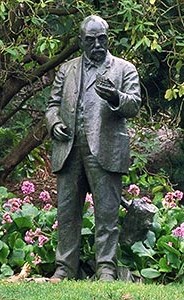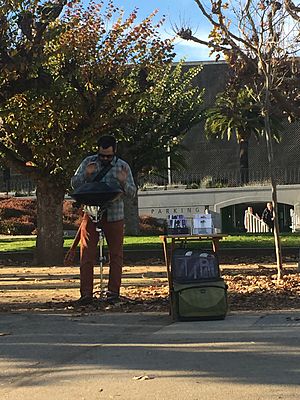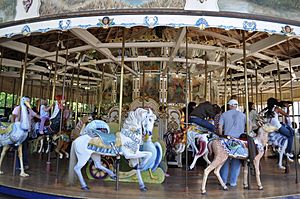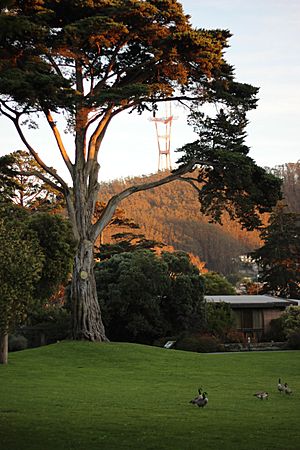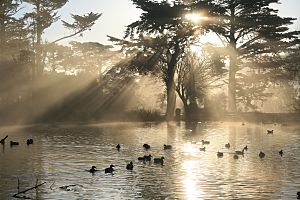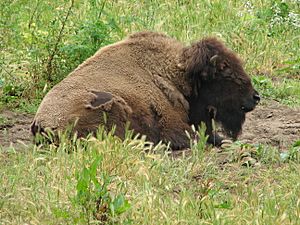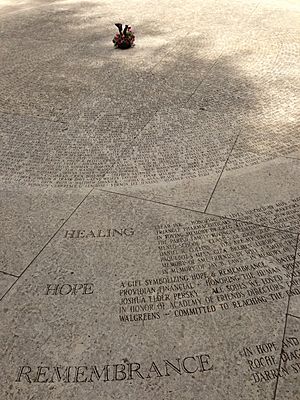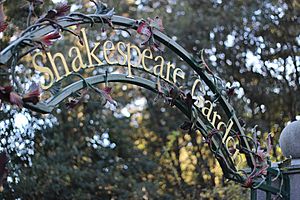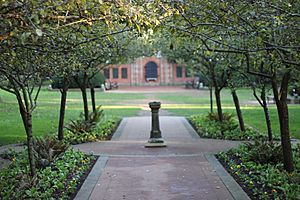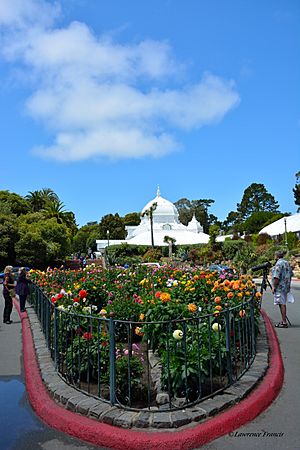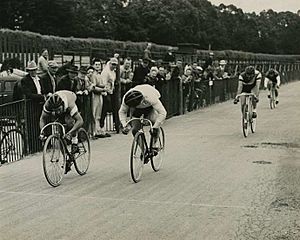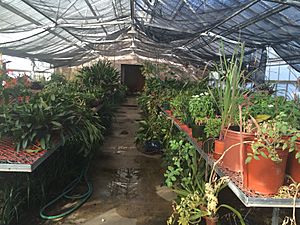Golden Gate Park facts for kids
Quick facts for kids Golden Gate Park |
|
|---|---|
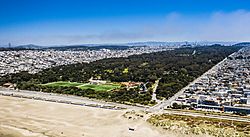
Aerial photograph of Golden Gate Park, 2020
|
|
| Type | Urban Park |
| Location | San Francisco, California, United States |
| Area | 1,017 acres (4.12 km2) |
| Visitors | 24 million |
| Open | All year |
| Architect | William Hammond Hall John McLaren Calvert Vaux |
| Architectural style | Olmsted, Vaux & Co.-influenced |
| NRHP reference No. | 04001137 |
| Added to NRHP | October 15, 2004 |
Golden Gate Park, located in San Francisco, California, United States, is a very large urban park. It covers about 1,017 acres (4.12 km²) of public land. The San Francisco Recreation & Parks Department manages the park. This department started in 1871 to help develop Golden Gate Park.
The park is shaped like a rectangle. It is similar to, but 20 percent larger than, Central Park in New York City. Golden Gate Park is over three miles (4.8 km) long from east to west. It is about half a mile (0.8 km) wide from north to south. With 24 million visitors each year, Golden Gate Park is the third most-visited city park in the United States. Only Central Park and the Lincoln Memorial get more visitors.
Contents
History of Golden Gate Park
How the Park Was Built
In the 1860s, people in San Francisco wanted a large public park. They wanted something like Central Park in New York City. Golden Gate Park was created from sandy areas and dunes. These lands were known as the Outside Lands. They were west of San Francisco's city limits at the time.
In 1865, Frederick Law Olmsted suggested a park plan. It would use plants that naturally grew in San Francisco's dry climate. However, his idea was not chosen. Instead, they picked a plan for a park that needed a lot of watering, like Central Park. The park was meant for fun, but it also helped the city grow westward.
William Hammond Hall surveyed the park area in 1870. He became its commissioner in 1871. He later became California's first state engineer. He helped create a system to control floods in the Sacramento Valley. The park got its name from the nearby Golden Gate Strait.
Hall and his assistant, John McLaren, developed the park's design and planting. McLaren learned gardening in Scotland. He promised to make Golden Gate Park "one of the beauty spots of the world." He also said he would "recreate what nature had done" in the garden.
The first step was to plant trees. This helped to hold the sand dunes in place. These dunes covered three-quarters of the park. John McLaren grew special bent grass seeds from France for two years. He then planted them over the sand to keep the ground together. After this, McLaren brought in new types of plants. He is said to have added over 700 new kinds of trees to California in one year.
By 1875, about 60,000 trees were planted. Most were Eucalyptus globulus, Monterey pine, and Monterey cypress. By 1879, this number more than doubled to 155,000 trees. During his life, McLaren planted over two million trees in northern California.
John McLaren also created a walking path along the Pacific Ocean. This was on the western edge of the park. He built an esplanade by stacking thousands of tree branches over 20 years. This was difficult because of strong tides and winds.
McLaren refused to retire at age 60. When he turned 70, a special rule was passed so he didn't have to retire. On his 92nd birthday, two thousand people honored him. He lived in McLaren Lodge in Golden Gate Park until he died in 1943 at 96. McLaren Avenue in Sea Cliff is named after him.
In 1903, two Dutch-style windmills were built at the park's far western end. They pumped water throughout the park. The north windmill was fixed in 1981. It is next to the Queen Wilhelmina tulip garden, a gift from Queen Wilhelmina of the Netherlands. These gardens have tulips in winter and other flowers in other seasons. The Murphy Windmill in the park's southwest corner was fixed in September 2011.
Park's Role After the 1906 Earthquake
After the big earthquake in San Francisco in 1906, Golden Gate Park became a safe place for many people. They had lost their homes. The undeveloped Outside Lands became a good spot to house these people. Many "earthquake shacks" were built all over the area. The United States Army controlled 21 of the 26 official homeless camps in the Golden Gate Park area.
The Army housed 20,000 people in military-style camps. About 16,000 of these people lived at the Presidio. There were four main camps there, including one just for Chinese immigrants. The Army set up 3,000 tents in a grid, like a town, with streets and addresses. They built a "virtual town" with temporary tent homes, bathrooms, bathhouses, laundries, and other services.
People formed small communities in the tent neighborhoods. Children made play areas, and adults met in the dining halls to talk. In June 1906, the Presidio tent camps closed. San Francisco built more permanent homes. Army carpenters built these "earthquake shacks." Residents paid for them over 25 months at two dollars a month.
The camps mainly helped people who couldn't find other places to live or couldn't support themselves. The park's refugee camps were temporary. They were used while horse stables at Ingleside were fixed up for people to live in. The relief camps in the park eventually closed as the city recovered. However, some buildings from that time still stand today.
Later Years and Improvements
During the Great Depression in the 1930s, the San Francisco Parks and Recreation Department ran out of money. The Works Progress Administration (WPA) took over some duties. The WPA was a government program that created jobs and improved communities during hard economic times.
The WPA helped create several parts of the park. These include the Arboretum, the archery field, and the model yacht club. They also rebuilt 13 miles of roads and built horse stables for the San Francisco Police Department. The Anglers Lodge and its fly casting pools, built by the WPA, are still used today. The horseshoe pits were also made by WPA workers. They came with two sculptures by artist Jesse S. "Vet" Anderson.
Most of the water for the park's plants and water features now comes from underground water. This water is from the city's Westside Basin Aquifer.
A small part of the park at the far east end is called the Panhandle. It is north of Haight-Ashbury. This was the site of the Human Be-In in 1967, which happened before the Summer of Love.
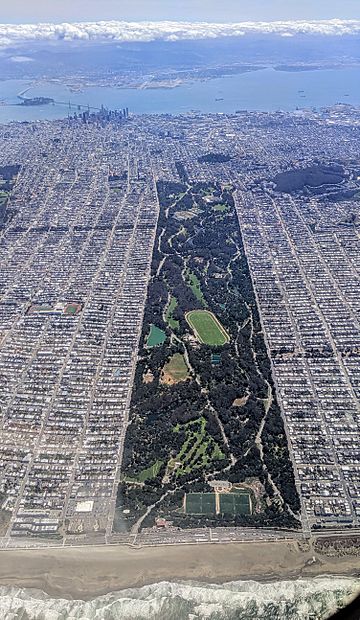
Hippie Hill
Hippie Hill is a green, gently sloping lawn. It is nestled among trees between the Conservatory of Flowers and Haight Street. It overlooks Robin Williams Meadow. Eucalyptus and Oak trees grow on either side. This spot shows a unique part of San Francisco's history.
Hippie Hill was a key location during the Summer of Love in 1967. This was a large counterculture movement. Because it was so close to Haight Street, the main area of the Summer of Love, the movement often spread onto the hill. During this time, people gathered here to connect. They played music and shared hippie ideas. Over time, local residents complained about the loud dancing and trash.
Music also became a part of the hill's history. Musicians and bands like Janis Joplin, the Grateful Dead, Jefferson Airplane, and George Harrison played free shows nearby. Today, improvised drum circles often form on weekends. People gather to play a steady beat for hours.
Music Concourse Area
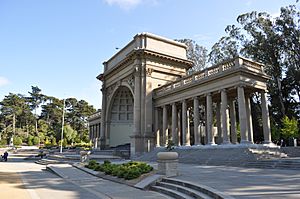
The Music Concourse is a sunken, oval-shaped outdoor area. It was first dug out for the California Midwinter International Exposition of 1894. The main part of the Concourse is the Spreckels Temple of Music, also called the "Bandshell." Many music shows have been held here.
During fall, spring, and summer, food trucks often park behind the Bandshell. They offer local food to visitors. You can also rent bicycles and surrey bikes behind the bandshell. The area has statues of historical figures, four fountains, and many trees. Since 2003, the Music Concourse has been improved. It now has an underground parking garage for 800 cars. The plaza itself is now only for people walking. It is surrounded by several cultural attractions:
De Young Museum


The De Young Museum is a fine arts museum. It opened in January 1921. It is named after M. H. de Young, a San Francisco newspaper owner. The museum's first building was part of the 1894 Midwinter Exposition. Mr. de Young was the director of this event.
The original De Young Memorial Museum stood for most of the 20th century. It was completely rebuilt in 2001 and reopened in 2005. The main architects, Jacques Herzog and Pierre de Meuron, wanted to create a place where art felt less formal. The building is mostly made of copper. Its unique design was made to look even better with sunlight and San Francisco's fog.
Today, the De Young Museum features American art, Modern art, African art, textiles, and sculptures. It also has special changing exhibitions.
California Academy of Sciences

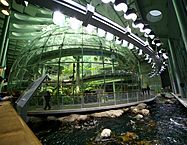
The California Academy of Sciences started in 1853. This makes it the oldest science institution in the western United States. Charles Darwin, who developed the theory of evolution, helped with its early organization. The original museum had eleven buildings. They were built between 1916 and 1976.
The museum was badly damaged in the 1989 earthquake. Only three original buildings were saved for the new construction: the African Hall, the North American Hall, and the Steinhart Aquarium. The new building opened in 2008 in the same spot in the park. This building is 37,000 square meters. It has exhibits on natural history, ocean life, space, gems, minerals, and earthquakes.
The academy also has a 2.5-acre living roof. It has almost 1.7 million native California plants. Domes on the roof cover the planetarium and rainforest exhibits. The roof's soil is six inches deep. This reduces rainwater runoff by over 90%. It also naturally cools the museum inside, so less air conditioning is needed. The glass panels on the living roof collect over 5% of the electricity the museum needs. Because of its eco-friendly design, the California Academy of Sciences is the only LEED-platinum certified museum in the country. This award is given by the U.S. Green Building Council.
Japanese Tea Garden
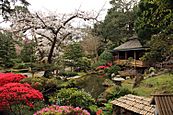

The Japanese Tea Garden is the oldest public Japanese garden in the United States. It covers five of the park's 1,017 acres. It is next to the de Young Museum. Some say it's where the fortune cookie was first introduced in America.
George Turner Marsh created the garden as a "Japanese Village" for the 1894 Midwinter Exposition. After the fair, Japanese Horticulturalist Makoto Hagiwara took over the garden. He helped change it from a temporary exhibit to a permanent part of the park. Hagiwara and his family lived there and took care of the garden until 1942.
In 1942, during World War II, Makoto Hagiwara's daughter, Takano Hagiwara, and her children were forced to leave the gardens. They were sent to internment camps due to Executive Order 9066. During the war, the garden was renamed the "Oriental Tea Garden" because of anti-Japanese feelings. After the war, people wrote letters to get the garden's original name back. It was officially renamed the Japanese Tea Garden in 1952.
In 1953, a classical Zen garden and the Lantern of Peace were added. The Lantern of Peace weighs 9,000 pounds. It was a gift from the Japanese Government to help heal relations between the U.S. and Japan after World War II. A plaque, designed by Ruth Asawa, honors Hagiwara and his family at the garden's entrance. The garden still has features like the Drum Bridge and the Tea House from the Midwinter Exposition.
Like other Japanese tea gardens, this one has stepping stone paths, stone lanterns, and various plants. You can find dwarf trees, bamboo, and azaleas. The Japanese Tea Garden is a peaceful place in the busy Golden Gate Park. It helps visitors feel connected to nature.
Structures and Buildings
Conservatory of Flowers
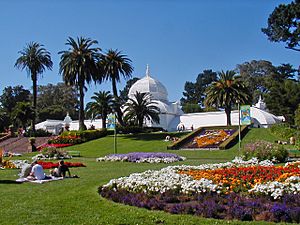
The Conservatory of Flowers opened in 1879. It is the oldest building in Golden Gate Park. It is one of the largest conservatories in the U.S. It is also one of the few large Victorian greenhouses in the country. The Conservatory is made of wood and glass. It is 12,000 square feet and holds 1,700 types of tropical, rare, and water plants.
William Hammond Hall included the idea of a conservatory in his original park design. Twenty-seven wealthy business owners in San Francisco helped make it happen. In 1883, a boiler exploded, and the main dome caught fire. Charles Crocker helped pay for its repair. It survived the 1906 earthquake but had another fire in 1918. In 1995, a severe storm damaged it. It was closed for repairs and reopened in September 2003.
The Conservatory has different rooms:
- The Potted Plants Gallery shows tropical plants in a Victorian style.
- The Lowlands Gallery has plants from South American tropics.
- The Highlands Gallery has native plants from South and Central America.
- The Aquatic Plants room has conditions like those near the Amazon River.
Beach Chalet
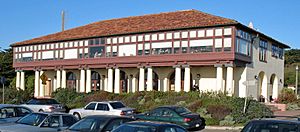
The two-story Beach Chalet faces the Great Highway and Ocean Beach. It is at the far western end of the park. It has restaurants and murals from the 1930s.
Windmills
Before the windmills, Golden Gate Park paid a lot for water. To save money, the North (Dutch) Windmill was built in 1902. It was needed because the park's water pump wasn't enough. The windmill pumps water from underground. It sends fresh water back into the park. It can pump 30,000 gallons of water per hour. This water fills Lloyd Lake, Metson Lake, Spreckels Lake, and Lincoln Park.
Because the North Windmill was successful, a second windmill was built. This was the South Windmill, also called the Murphy Windmill. It is the largest windmill in the world. It can lift 40,000 gallons of water per hour.
Statues in the Park
A statue of John McLaren is in the Rhododendron Dell. He had this statue hidden, and it was only placed there after he died. Other statues of historical figures are also around the park. These include Francis Scott Key, Robert Emmet, Robert Burns, Johann Goethe and Friedrich Schiller, General Pershing, Beethoven, Giuseppe Verdi, President Garfield, and Thomas Starr King.
A bronze statue of Don Quixote and his friend, Sancho Panza, honors their creator, Cervantes. At the Horseshoe Court, there is a concrete carving called The Horseshoe Pitcher. Across from the Conservatory of Flowers is Douglas Tilden's The Baseball Player.
On June 19, 2020, during protests, some statues were pulled down or damaged. These included statues of Catholic missionary Junípero Serra, Francis Scott Key (who wrote the words to The Star-Spangled Banner), Ulysses S. Grant, Cervantes, Don Quixote, and Sancho Panza.
In the northwest part of the park, near the Beach Chalet, there is a monument to explorer Roald Amundsen. It also honors the Gjøa, the first ship to travel through the Northwest Passage. The Gjøa was given to the city in 1906. It was displayed for many years near Ocean Beach. After it fell apart, the Gjøa was sent back to Norway in 1972.
Prayer Book Cross
The Prayer Book Cross, also called Drake's Cross, is a tall sandstone Celtic-style cross. It is 60 feet (18 meters) tall. It was put up in 1894 by Episcopalians. It remembers Sir Francis Drake's first landing on the West Coast in 1579. It also marks the first time the Book of Common Prayer was used in California. The cross was meant to be seen by ships at sea, but trees have grown around it.
Carousel and Koret Playground
An old, fancy carousel with many animal figures is in a round building. It is near the children's playground. The carousel was built in 1914. This building had three other carousels before the current one. The current carousel was bought in 1941. The 1914 carousel has been fixed up many times. In 1977, it closed for safety. Artist Ruby Newman helped restore it. She hand-painted all the animals and decorations. The carousel reopened in 1984. Today, it has 62 animals, a German Band Organ, and painted scenes of the Bay Area.
The Koret Playground surrounds the carousel. It was originally called the Children's Quarters. It was planned to be a main part of Golden Gate Park from the beginning. It was finished in 1888 and was a place for children and their mothers. It was the first public children's playground in the United States. It had swings, indoor areas, sitting spots, and the original carousel. In 2007, the Koret Foundation paid for renovations.
Natural Features
San Francisco Botanical Garden
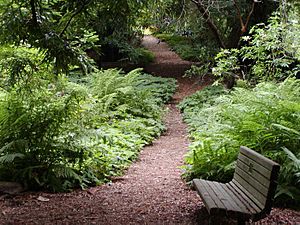
The San Francisco Botanical Garden was planned in the 1890s. But it didn't get enough money until Helene Strybing left funds in 1926. Planting started in 1937 with WPA money and local donations. This 55-acre (0.22 km²) arboretum has more than 7,500 plant types. It also has the Helen Crocker Russell Library, which is northern California's largest gardening library.
Because of San Francisco's unique climate, the plants in the Botanical Garden come from many countries. Some no longer exist in their natural homes. They come from places like Africa, Australia, New Zealand, and Central and South America. These areas range from desert to tropical. The garden also has native California plants, like Redwood trees.
Lakes in the Park
Stow Lake goes around Strawberry Hill. This hill is now an island with a waterfall. The lake was named after W.W. Stow, who gave money for its building. Strawberry Hill's waterfall is called Huntington Falls. Stow Lake was the first artificial lake in the park. Huntington Falls was the park's first artificial waterfall. You can rent rowboats and pedal boats at the boathouse. You can see much of western San Francisco from the top of Strawberry Hill.
Spreckels Lake is an artificial lake. It is on the north side of Golden Gate Park. It is named after Adolph B. Spreckels, a sugar heir and park commissioner. It was built between 1902 and 1904 for model boats. You can often see both 'sail-driven' model yachts and electric or gas-powered radio-controlled model boats on the lake.
Elk Glen Lake is the park's deepest ornamental lake. It is over 6 feet (1.8 meters) deep on average. This lake holds water from the Reclamation Plant. This water is then pumped to Stow Lake or Strawberry Hill.
Mallard Lake is not connected to the park's watering system.
Metson Lake is west of Mallard Lake. It can hold over 1.1 million gallons of water. This water can flow into South Lake or be used for watering.
Chain of Lakes Many natural-looking lakes are in the park. Several are linked together, with pumped water creating flowing creeks. Golden Gate Park was built on 14 natural marshy lakes. Only 5 remain, and three of them form the Chain of Lakes. These three lakes are North, Middle, and South Lake. They are along Chain of Lakes Drive.
North Lake is the largest of the three. It is known for its water birds. You can see egrets, belted kingfishers, ducks, and great blue herons. A paved path goes around it, used by families, joggers, and dog walkers.
Middle Lake is good for bird-watching. Migrant birds like tanagers, warblers, and vireos visit it. A dirt trail and plants surround it. This lake looks like the marshes that were there before Golden Gate Park. It is known for being a quiet and romantic spot.
South Lake is the smallest of the three lakes. It borders Martin Luther King Jr. Drive. Its water comes from Metson Lake or Stow Lake. It does not help water the park, but it flows into Middle Lake. Its main bird population is ducks.
Bison Paddock
Bison have lived in Golden Gate Park since 1891. A small group was bought by the park commission. At that time, the number of bison in North America was very low. San Francisco helped breed them in captivity. In 1899, the paddock in the western part of the park was created. At its best, the park produced over 100 bison calves. This helped save the bison population in North America. Bison were very important to the culture of Native Americans.
In 1984, Mayor Dianne Feinstein's husband, Richard C. Blum, bought a new group of bison as a birthday gift for his wife. The older bison in the paddock today are descendants of this group. In 2011, more bison were added to the herd. The paddock is open for people to see the bison.
Plants in the Park
Golden Gate Park has many different plants from all over the world. Sydney golden wattle trees from Australia were some of the first planted. William Hammond Hall planted them to hold the sand dunes in place. They still do this in the western part of the park.
Most of the park is not a natural area. However, four of San Francisco's 32 natural areas are in Golden Gate Park. These are the Oak Woodlands, the Lily Pond, Strawberry Hill, and Whiskey Hill.
The California live oak is the only tree native to the park. Some of the oldest plants are the coast live oaks in the Oak Woodlands. They are hundreds of years old. Oaks also grow on Strawberry Hill and in the AIDS Memorial Grove. Acorns from oak trees were an important food source for Native American groups in San Francisco.
Other plants in the park are not native. Some are invasive species. They can harm birds, mammals, reptiles, and insects in the park. Volunteers are working to remove invasive plants on Strawberry Hill. They are replacing them with native plants to help butterflies.
Blue gum eucalyptus, Monterey pine, and Monterey cypress were the most common trees planted in the late 1800s. Blue gum trees are still very important in the park. You can find them near McLaren Lodge, on Hippie Hill, and in a eucalyptus forest near Middle Lake. Monterey pines are also common. They are in the Strybing Arboretum, the Japanese Tea Garden, and around the Bison Paddock.
Redwoods were planted in the 1880s. You can find them all over the park. They are especially in Heroes Grove, Redwood Memorial Grove, AIDS Memorial Grove, Stanyan Meadows, on Hippie Hill, and in the Panhandle.
Tree ferns were planted early by McLaren. Many are in the Tree Fern Dell, near the Conservatory of Flowers. This area is mostly made of Tasmanian tree ferns.
Wild Animals
In 2013, a photographer saw coyote pups in Golden Gate Park. It is thought that over 100 coyotes live in San Francisco. More sightings happen in Golden Gate Park than anywhere else in the city. Coyotes have adapted well to the city, even though they usually live in open prairies and deserts. Mountain lions sometimes roam the park. The first group of great blue herons to nest in San Francisco was found at Stow Lake in 1993. They have been returning to the park to breed ever since.
Dedicated Areas and Memorials
National AIDS Memorial Grove
After the first reports of AIDS in the United States in 1981, many Americans were affected. In 1988, some San Francisco residents imagined a place to remember those who died from AIDS. They wanted a peaceful memorial where people could heal. Work on the National Aids Memorial Grove began in September 1991. It continues today as communities work to improve it.
The Grove is at 856 Stanyan Street, in the eastern part of Golden Gate Park. It covers seven acres of land. In 1996, thanks to Nancy Pelosi's efforts, the "National AIDS Memorial Grove Act" was passed. President Bill Clinton officially made these seven acres the first AIDS memorial in the United States. In 1999, it won an award for excellence in urban environments.
This memorial is a peaceful place with redwoods, maples, ferns, benches, and boulders. People go there to grieve, hope, heal, and remember. The Circle of Friends is at the heart of the grove. It has over 1,500 names carved into its flagstone ground. These names represent lives lost to AIDS. If someone wants to add a name, they donate $1,000. The name is added before World AIDS Day on December 1. The Grove is funded by private donations and cared for by over 500 volunteers.
Shakespeare Garden
The Shakespeare Garden is a "17th century classical garden." It is southwest of the California Academy of Sciences. It honors William Shakespeare and his plays. It is decorated with flowers and plants mentioned in his works. The entrance is a fancy metal gate that says "Shakespeare Garden" with vines. Inside, there is a walkway with trees, small flowers, and a sundial. The main area has a large moss tree and benches.
At the end of the garden, there is a wooden shelf with a bust of William Shakespeare. This statue was given to the garden in 1918. It has been kept behind locked doors since around 1950. This prevents people from cutting off pieces to melt down. Around the bust, there are four plaques with quotes from Shakespeare. Two original plaques were stolen.
Alice Eastwood, the botany director from the California Academy of Sciences, had the idea for the garden in 1928. Katherine Agnes Chandler carried it out. This garden is not unique; there are several Shakespeare gardens around the world. The garden is a popular place for weddings. It has over 200 plants from Shakespeare's works.
Rose Garden
The Rose Garden is between John F. Kennedy Drive and Park Presidio Boulevard.
Dahlia Garden
The Dahlia Garden is just east of the Conservatory of Flowers. Volunteers from the Dahlia Society of California, founded in 1917, maintain it.
Sports and Recreation
Golden Gate Park has many areas for sports and fun. These include tennis courts, soccer fields, baseball fields, lawn bowling fields, an angling and casting club, a disc golf course, horseshoe pits, an archery range, the polo field, and Kezar Stadium. Golden Gate Park started the first Lawn Bowling Club in the United States in 1901. Its clubhouse was built in 1915.
Kezar Stadium

Kezar Stadium was built between 1922 and 1925. It is in the southeast corner of the park. It hosted many sports events. It was the home stadium for the San Francisco 49ers football team from 1946 to 1970. For one season in 1960, it also hosted the Oakland Raiders.
The original 59,000-seat stadium was torn down in 1989. It was replaced with a modern 9,044-seat stadium. This new stadium has a copy of the original concrete arch at its entrance.
In recent years, the stadium has been used for soccer, lacrosse, and track and field. It also hosts the annual city high school football championship, the Turkey Bowl. This game dates back to 1924 and is played every Thanksgiving.
The Polo Field
The sport of polo came to California in 1876. The California Polo Club was started with help from Captain Nell Mowry. In 1906, the Golden Gate Park Stadium was built. It had a polo field and a cycling track. Later, the stadium was simply called the Polo Field. In the mid-1930s, the city used government funds to fix up the polo field. Polo continued to be played through the 1940s. By the 1950s, polo stopped being played here regularly.
Today, polo is not regularly played on the Polo Field. However, "Polo in the Park" was held annually from 2006 to 2010. The Polo Fields also have a long history with cycling. They were first created for track cycling in 1906. Track cycling was very popular in the early 1900s.
The field has a rich history of music and events. Many major music festivals have taken place here. These include the Human Be-In, with bands like the Grateful Dead and Jefferson Airplane. More recent music festivals, like Outside Lands and Hardly Strictly Bluegrass, also happen on or near the Polo Fields. One of the largest public gatherings in San Francisco happened here: a public Rosary in 1961 with 550,000 people. Political events were also held here, such as an anti-Vietnam War rally in 1969.
Today, the Polo Field is divided. It has an inner soccer field and a flat cycling track around it. Many sports are played here, including soccer, cross country running, and different types of cycling. The cycling track is still active, with many time-trial races each season.
Archery Range
Archery was first organized in Golden Gate Park in 1881. However, there wasn't a special range for archery until around 1933. In 1936, during Franklin D. Roosevelt's presidency, many parts of Golden Gate Park were improved. This was part of the Works Progress Administration (WPA) program. With WPA help, the archery range was made bigger. The hill next to it was shaped to stop stray arrows. Hay bales are used as targets. They are provided by the Golden Gate Joad Archery Club and other donors.
The Golden Gate Park Archery Range is inside the park, off 47th Street and Fulton Street. It is open whenever the park is open and is free to use. There are no staff or equipment rentals at the range. However, there are archery stores nearby for rentals. Multiple groups offer training and lessons.
Golden Gate Park Nursery
The Golden Gate Park Nursery started in 1870. It has been one of the few areas in the park not open to the public. This nursery began with plants donated from around the world. It grew over the years with the care of past Golden Gate Park gardeners. The nursery has moved three times. First, it was where McLaren Lodge is now. Then, it moved to where Kezar Stadium is. Finally, it moved to its current spot on Martin Luther King Jr. Drive. This Nursery has over 800 types of plants. Some are only found at the nursery. They are sold to the public on the third Saturday of each month. Every week, over 3,000 plants are sent out to the city and park.
Images for kids
-
A scene from the Charlie Chaplin film A Jitney Elopement, filmed in Golden Gate Park
See also
 In Spanish: Golden Gate Park para niños
In Spanish: Golden Gate Park para niños


